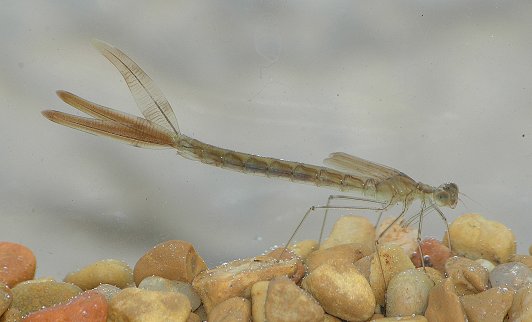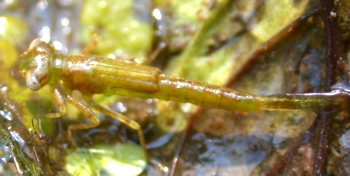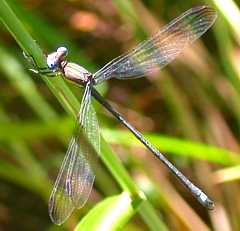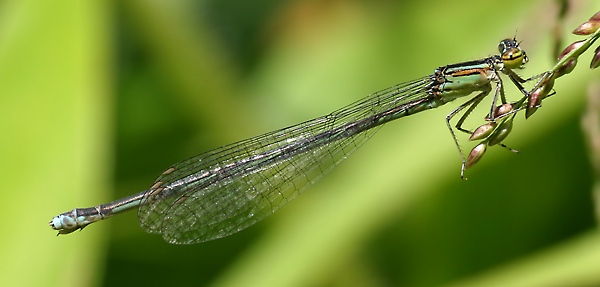Adaptation
Let’s look at adaptations as damselflies move through their
life cycle.
 Males
have claws that they use to hold the female damselfly when they
are mating. Once that’s over, females use ovipositors that
help them lay eggs on overhanging plants or sheltered surfaces
underwater. They also produce fewer eggs because they live
close to water sources, and this results in a high success rate.
While most damselflies live near constant water sources, some
are not as fortunate and deposit eggs in ponds that may dry.
In this case, the damselfly eggs are diapausing so they
can survive the dry spells; once water refills the pond, the
eggs will hatch, and the life cycle continues.
Males
have claws that they use to hold the female damselfly when they
are mating. Once that’s over, females use ovipositors that
help them lay eggs on overhanging plants or sheltered surfaces
underwater. They also produce fewer eggs because they live
close to water sources, and this results in a high success rate.
While most damselflies live near constant water sources, some
are not as fortunate and deposit eggs in ponds that may dry.
In this case, the damselfly eggs are diapausing so they
can survive the dry spells; once water refills the pond, the
eggs will hatch, and the life cycle continues.
 After
the eggs hatch into naiads, there are new adaptations. The
naiads that live in fast-flowing streams have claws that help
them hold on to surfaces to make sure the current does not sweep
them away. Other naiads use their long legs to help them
walk and prey on other organisms. Their three feathery
gills have large surface areas, allowing for higher levels of
gas exchange while breathing.
After
the eggs hatch into naiads, there are new adaptations. The
naiads that live in fast-flowing streams have claws that help
them hold on to surfaces to make sure the current does not sweep
them away. Other naiads use their long legs to help them
walk and prey on other organisms. Their three feathery
gills have large surface areas, allowing for higher levels of
gas exchange while breathing.
Naiads developed two different life cycles in order to decrease
predation risks. Slow life style naiads do not have high
activity levels and do not use most of their habitat's space; as
a result, they develop low metabolisms, feeding, growth, and
development patterns. On the other hand, naiads may life a
fast life style where they live in ponds that dry periodically;
this means
 that the predators do not have enough time to
complete their life cycles and that the naiads must develop
quickly so they do not perish either. In these cases, the
naiads move quickly with fast metabolisms and high levels of
activity and habitat use; fast life style naiads complete their
life cycle much more quickly than slow life style naiads.
that the predators do not have enough time to
complete their life cycles and that the naiads must develop
quickly so they do not perish either. In these cases, the
naiads move quickly with fast metabolisms and high levels of
activity and habitat use; fast life style naiads complete their
life cycle much more quickly than slow life style naiads.
 Before adults fly each day, they have to warm themselves, so
they must have sunlight, not cloudy days. To make sure it
is warm enough, the damselfly basks in the sun to absorb as many
rays as possible. Then, the damselfly shivers its flight
muscles rapidly to create its own body heat in addition to the
sun’s heat. However, if the damselfly is larger, it may
over heat, so to combat this, they take longer glides between
beating their wings. All these are forms of
thermoregulation!
Before adults fly each day, they have to warm themselves, so
they must have sunlight, not cloudy days. To make sure it
is warm enough, the damselfly basks in the sun to absorb as many
rays as possible. Then, the damselfly shivers its flight
muscles rapidly to create its own body heat in addition to the
sun’s heat. However, if the damselfly is larger, it may
over heat, so to combat this, they take longer glides between
beating their wings. All these are forms of
thermoregulation!
Damselfly adult legs are strong, but are more often used to capture and hold prey instead of walking.
 Compound eyes help damselflies to integrate sensory
information from their environment to help them survive.
Each eye is made of thousands of ommatidia; an ommatidia has a
lens with receptor cells that captures a portion of an image.
The damselfly's brain gathers all the individual images to
create one, large picture. As a result of the high amounts
of visual information, a damselfly's brain has a highly
developed optic center to accommodate the sensory signals.
Compound eyes help damselflies to integrate sensory
information from their environment to help them survive.
Each eye is made of thousands of ommatidia; an ommatidia has a
lens with receptor cells that captures a portion of an image.
The damselfly's brain gathers all the individual images to
create one, large picture. As a result of the high amounts
of visual information, a damselfly's brain has a highly
developed optic center to accommodate the sensory signals.
Wow! Damselflies are complex organisms! Are you hungry? Click here to see if you would like to eat lunch with a damselfly.
